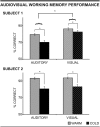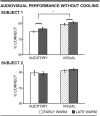Inactivation of Primate Prefrontal Cortex Impairs Auditory and Audiovisual Working Memory
- PMID: 26134649
- PMCID: PMC4571503
- DOI: 10.1523/JNEUROSCI.1218-15.2015
Inactivation of Primate Prefrontal Cortex Impairs Auditory and Audiovisual Working Memory
Abstract
The prefrontal cortex is associated with cognitive functions that include planning, reasoning, decision-making, working memory, and communication. Neurophysiology and neuropsychology studies have established that dorsolateral prefrontal cortex is essential in spatial working memory while the ventral frontal lobe processes language and communication signals. Single-unit recordings in nonhuman primates has shown that ventral prefrontal (VLPFC) neurons integrate face and vocal information and are active during audiovisual working memory. However, whether VLPFC is essential in remembering face and voice information is unknown. We therefore trained nonhuman primates in an audiovisual working memory paradigm using naturalistic face-vocalization movies as memoranda. We inactivated VLPFC, with reversible cortical cooling, and examined performance when faces, vocalizations or both faces and vocalization had to be remembered. We found that VLPFC inactivation impaired subjects' performance in audiovisual and auditory-alone versions of the task. In contrast, VLPFC inactivation did not disrupt visual working memory. Our studies demonstrate the importance of VLPFC in auditory and audiovisual working memory for social stimuli but suggest a different role for VLPFC in unimodal visual processing.
Significance statement: The ventral frontal lobe, or inferior frontal gyrus, plays an important role in audiovisual communication in the human brain. Studies with nonhuman primates have found that neurons within ventral prefrontal cortex (VLPFC) encode both faces and vocalizations and that VLPFC is active when animals need to remember these social stimuli. In the present study, we temporarily inactivated VLPFC by cooling the cortex while nonhuman primates performed a working memory task. This impaired the ability of subjects to remember a face and vocalization pair or just the vocalization alone. Our work highlights the importance of the primate VLPFC in the processing of faces and vocalizations in a manner that is similar to the inferior frontal gyrus in the human brain.
Keywords: monkey; multisensory; visual working memory; vocalization.
Copyright © 2015 the authors 0270-6474/15/359666-10$15.00/0.
Figures








Similar articles
-
Multisensory interactions of face and vocal information during perception and memory in ventrolateral prefrontal cortex.Philos Trans R Soc Lond B Biol Sci. 2023 Sep 25;378(1886):20220343. doi: 10.1098/rstb.2022.0343. Epub 2023 Aug 7. Philos Trans R Soc Lond B Biol Sci. 2023. PMID: 37545305 Free PMC article. Review.
-
Prefrontal neuronal responses during audiovisual mnemonic processing.J Neurosci. 2015 Jan 21;35(3):960-71. doi: 10.1523/JNEUROSCI.1328-14.2015. J Neurosci. 2015. PMID: 25609614 Free PMC article.
-
Responses of prefrontal multisensory neurons to mismatching faces and vocalizations.J Neurosci. 2014 Aug 20;34(34):11233-43. doi: 10.1523/JNEUROSCI.5168-13.2014. J Neurosci. 2014. PMID: 25143605 Free PMC article.
-
Timing of audiovisual inputs to the prefrontal cortex and multisensory integration.Neuroscience. 2012 Jul 12;214:36-48. doi: 10.1016/j.neuroscience.2012.03.025. Epub 2012 Apr 16. Neuroscience. 2012. PMID: 22516006 Free PMC article.
-
Integration of faces and vocalizations in ventral prefrontal cortex: implications for the evolution of audiovisual speech.Proc Natl Acad Sci U S A. 2012 Jun 26;109 Suppl 1(Suppl 1):10717-24. doi: 10.1073/pnas.1204335109. Epub 2012 Jun 20. Proc Natl Acad Sci U S A. 2012. PMID: 22723356 Free PMC article. Review.
Cited by
-
Semantically congruent bimodal presentation modulates cognitive control over attentional guidance by working memory.Mem Cognit. 2024 Jul;52(5):1065-1078. doi: 10.3758/s13421-024-01521-y. Epub 2024 Feb 2. Mem Cognit. 2024. PMID: 38308161
-
Multisensory interactions of face and vocal information during perception and memory in ventrolateral prefrontal cortex.Philos Trans R Soc Lond B Biol Sci. 2023 Sep 25;378(1886):20220343. doi: 10.1098/rstb.2022.0343. Epub 2023 Aug 7. Philos Trans R Soc Lond B Biol Sci. 2023. PMID: 37545305 Free PMC article. Review.
-
Functional network properties of the auditory cortex.Hear Res. 2023 Jun;433:108768. doi: 10.1016/j.heares.2023.108768. Epub 2023 Apr 12. Hear Res. 2023. PMID: 37075536 Free PMC article. Review.
-
The hearing hippocampus.Prog Neurobiol. 2022 Nov;218:102326. doi: 10.1016/j.pneurobio.2022.102326. Epub 2022 Jul 21. Prog Neurobiol. 2022. PMID: 35870677 Free PMC article. Review.
-
Representation of Expression and Identity by Ventral Prefrontal Neurons.Neuroscience. 2022 Aug 1;496:243-260. doi: 10.1016/j.neuroscience.2022.05.033. Epub 2022 May 30. Neuroscience. 2022. PMID: 35654293 Free PMC article.
References
Publication types
MeSH terms
Grants and funding
LinkOut - more resources
Full Text Sources

